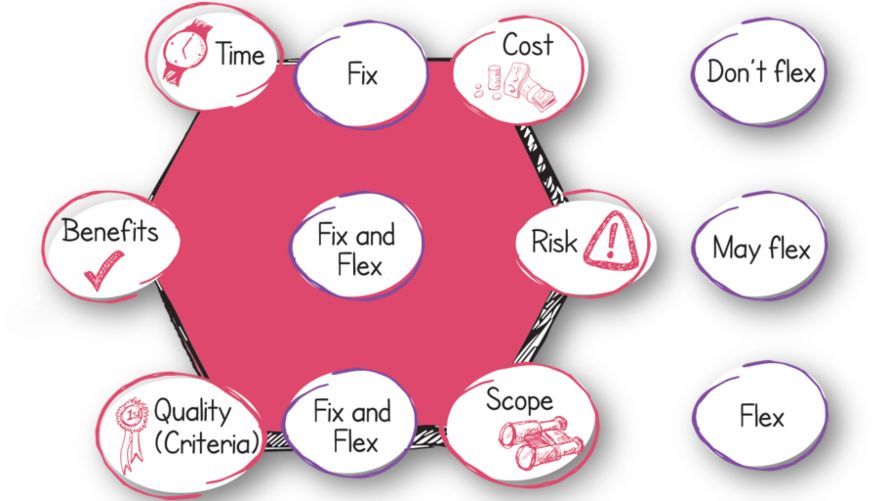
Fixing and flexing
Core PRINCE2 principles with an agile twist
While PRINCE2 Agile shares its foundational method with PRINCE2, it’s been specially adapted to suit an agile project environment. Drawing from PRINCE2’s 6th edition, but equally applicable to the latest PRINCE2 7th edition, PRINCE2 Agile incorporates the six performance aspects in PRINCE2, namely time, cost, scope, quality, risk, and benefits.
Setting tolerances
In PRINCE2’s approach, establishing tolerances for each of these six performance dimensions is paramount. By doing so, it sets clear boundaries and clarifies who holds decision-making authority. To illustrate, if a project manager is given certain tolerances by the project board and it’s anticipated that these might be surpassed, this situation is termed an ‘exception’. Such exceptions warrant an immediate escalation to the project board for appropriate action.
Dealing with exceptions
As a project unfolds and when deviations from the agree performance aspects begin to occur, PRINCE2 provides the tools to deal with such situations in the form of ‘management by exception’. This allows a project manager to tap into the tolerances of one performance dimension to address challenges in another, as long as no tolerances are breached in the process. For instance, if there’s a delay in project timelines, the project manager could potentially allocate more budget (drawing from the cost tolerance) to bring in extra resources to catch up.
In essence, within the PRINCE2 framework, the strategic use of one performance aspect to balance out challenges in another is a standard practice.
Fixing time and cost
Agile projects are different
In the realm of agile project management, the dynamics differ significantly from traditional methods. In the agile realm, work is planned in iterations (or cycles), often referred to as sprints. These sprints operate within set durations, creating fixed windows for work completion. Work for the sprint is planned based upon a prioritised set of requirements (commonly known as a backlog containing user stories).
Hence, in the agile framework, time is non-negotiable; there’s an absolute commitment to ensuring all tasks wrap up by the sprint’s conclusion. Tasks are organized based on a hierarchy of needs, usually captured as user stories on a backlog. This means that in agile projects, time tolerance is zero which limits the room to manoeuvre for a project manager when deviations from the plan start to occur.
Dealing with challenges to time by flexing scope
When unforeseen challenges arise in an agile setup, the solution isn’t to stretch the time but to refine the scope of work within the timebox. The mantra is straightforward: tackle the essentials first. Once the highest priority tasks are completed, the team can then focus on the next highest priority items, and if time permits, address the next highest priority elements.
Cost and team stability in Agile
Similarly, there is also zero cost tolerance in agile projects. The underlying assumption is that the team’s composition remains stable, especially within the span of a sprint. This stability is pivotal for maintaining momentum and ensuring ongoing collaboration.
So, whereas in traditional project management a project manager might react to deviations from the plan by spending more money on resources (e.g.. paying overtime or adding more staff) within the permitted cost tolerance, that option is not available within PRINCE2 Agile.
Instead, just as in the case of time tolerance, challenges are dealt with by varying the scope of what is delivered within the timebox. This distinct approach underscores the commitment of PRINCE2 Agile to flexibility, adaptability, and delivering value consistently.
PRINCE2 Agile and the hexagon
PRINCE2 Agile uses a hexagon as a symbolic representation for its six performance aspects, drawing from the foundational principles of PRINCE2. This geometric figure provides a visual guide to understand the interplay and flexibility associated with each aspect.
Fixed corners
Out of the six points of the hexagon, two are steadfast and non-negotiable: time and cost. In the realm of PRINCE2 Agile, these aspects come with zero tolerance, underscoring their significance in the project framework.
Flexible corners
Quality and scope occupy two other corners of the hexagon. Unlike the fixed counterparts, these aspects offer a degree of flexibility, allowing for adjustments as the project unfolds.
Variable corners
The remaining two corners, risk and benefits, are unique. Their flexibility is situational. Depending on the project’s nature and requirements, they can either be fixed, demanding strict adherence, or flexible, permitting some leeway.

Five targets of PRINCE2 Agile
The underlying rationale for the hexagon and the fixing and flexing of what is delivered is based upon the five targets of PRINCE2 Agile. These 5 targets are:
1. Be on time and hit deadlines.
No matter what, time is non-negotiable, so deadlines are always met which brings significant benefits.
2. Protect the level of quality.
By delivering to the level of quality expected by the users results in a total lower cost of ownership over the product’s lifetime.
3. Embrace change.
Change always happens, so expect change, and embrace change. By doing so, it enables a more accurate final product.
4. Keep teams stable.
Avoid the temptation to add or remove staff from a team during a timebox because stable teams are the most efficient.
5. Accept that the customer doesn’t need everything.
Accept that the customer doesn’t need everything they think they want in the early stages of a project. By accepting this, you can be flexible on the scope of what is delivered.
Summary
At the crux of PRINCE2 Agile lies the transformative concept of ‘fixing and flexing’. It’s a strategy that guarantees timely delivery by project teams while ensuring there’s no compromise on quality. Instead of rigidly sticking to a predefined scope, the scope becomes the variable, adapting based on evolving requirements and real-world challenges.
This adaptive approach empowers the project delivery team to cater directly to the genuine needs of the customer. By embracing an iterative and incremental delivery model, it becomes possible to not just meet but anticipate the ever-changing desires of the customer.
What’s more, this approach ensures that the customer begins to see tangible value early in the project lifecycle, fostering trust, satisfaction, and a shared commitment to success.
